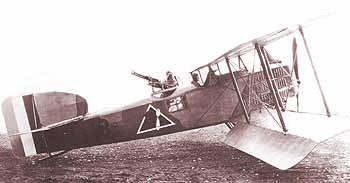 |
AIRCRAFTOF THEA E F |
Breguet 14A2 & 14B2

Development and OperationThe Louis Breguet design of his Breguet AV Type 14 aircraft was a major departure from his previous designs. Intended to survive the increasingly violent aerial combats of the Western Front the new design used a tractor layout, featured a low wing-loading, was intended for the Renault engine (over the objections of the Section Technique de l' Aéronautique [S.T.Aé.]), and for the first time extensively used duralumin in lieu of wood. The first prototype was powered by a 263 hp Renault and the second by the 272 hp Renault. The first prototype flew on 21 November 1916 at Villacoublay and was piloted by Louis Breguet. In November 1916 the S.T.Aé. had formulated a request for four types of aircraft. The Breguet 14A2 met the requirements for a 2-seat Army cooperation aircraft. The 14B2 version met the requirements for a day bomber. By 17 February the S.T.Aé. had completed its evaluation of the aircraft. Official orders were received on 6 March 1917. Each aircraft was armed with three machine guns. The Observer had a T.O. 3 or a T.O. 4 gun mount for his pair of 0.303 Vickers machine guns and the pilot had a fixed 0.303 inch Vickers machine gun mounted on the left side of the fuselage. The early B2 versions had Michelin bomb rack—carrying 32 11.5 kg of bombs. The A2 version could carry four bombs, a camera, and a wireless set. The principle difference between the A2 and the B2 versions were that the B2 had a lower wing with a span and had bunge-sprung flaps. In the absence of Liberty-powered D.H. 4's the U.S. Air Service initially ordered 376 Breguet aircraft (including 229 A2's and 47 B2's). About half of these had Fiat A-12 or A-12bis engines. The first American squadron to fly the Breguet operationally was the 96th Aero Squadron; which began training at the Michelin Bros. testing field on 1 December 1917. The 96th Aero took its Breguet to Amanty on 18 March 1918. However, apparently due to poor condition of the aircraft the first bombing raid was not flown until 12 June. On 10 July disaster struck the 96th when six Breguet 14's set out to bomb the railroad yards at Conflans. None of the aircraft made it back to Amanty. During the St.Mihiel Offensive the 96th Aero performed ground attack missions and bombed rail centers. Due to a combination of pilot inexperience and muddy airfields the 96th suffered the loss of 14 planes in five days. This is the worst loss rate of any A.E.F. unit during the war. In addition to the 96th Aero other A.E.F. squadron flying the Breguet were the 9th Night Reconnaissance Squadron and the 99th Corps Observation Squadron. |
Aircraft and Flight Characteristics
|
Length |
29 ft. 1.2 inches |
|
Height |
10 ft. 9.9 inches |
|
Empty Weight |
1,030 kg |
|
Loaded Weight |
1,565 kg |
|
Maximum Speed |
184 km/hr. |
|
Wing Span |
|
|
Upper wing |
47 ft. 1.5 inches |
|
Lower wing, 14A2 |
40 ft. 8 inches |
|
Lower wing, 14B2 |
44 ft. 9.8 inches |
|
Wing Chord (upper) |
6 ft. 6.7 inches |
|
Wing Chord (lower) |
6 ft. 7.8 inches |
|
Ceiling |
6,100 m |
|
Climb |
|
|
To 2,000 m |
6 minutes 50 seconds |
|
To 3,000 m |
11 minutes 35 seconds |
|
To 5,000 m |
29 minutes 30 seconds |
|
Endurance |
2.75 hrs. |
References:
- Davilla, J. and Art Soltan, French Aircraft of the First World War
- Lamberton, W.M., Reconnaissance and Bomber Aircraft
of the 1914-1918 War - Photo courtesy of Ray Mentzer
To find other Doughboy Features visit our |
Membership Information  Click on Icon |
For further information on the events of 1914-1918
visit the homepage of |
Michael E. Hanlon (medwardh@hotmail.com) regarding content,
or toMike Iavarone (mikei01@execpc.com) regarding form and function.
Original artwork & copy; © 1998-2000, The Great War Society